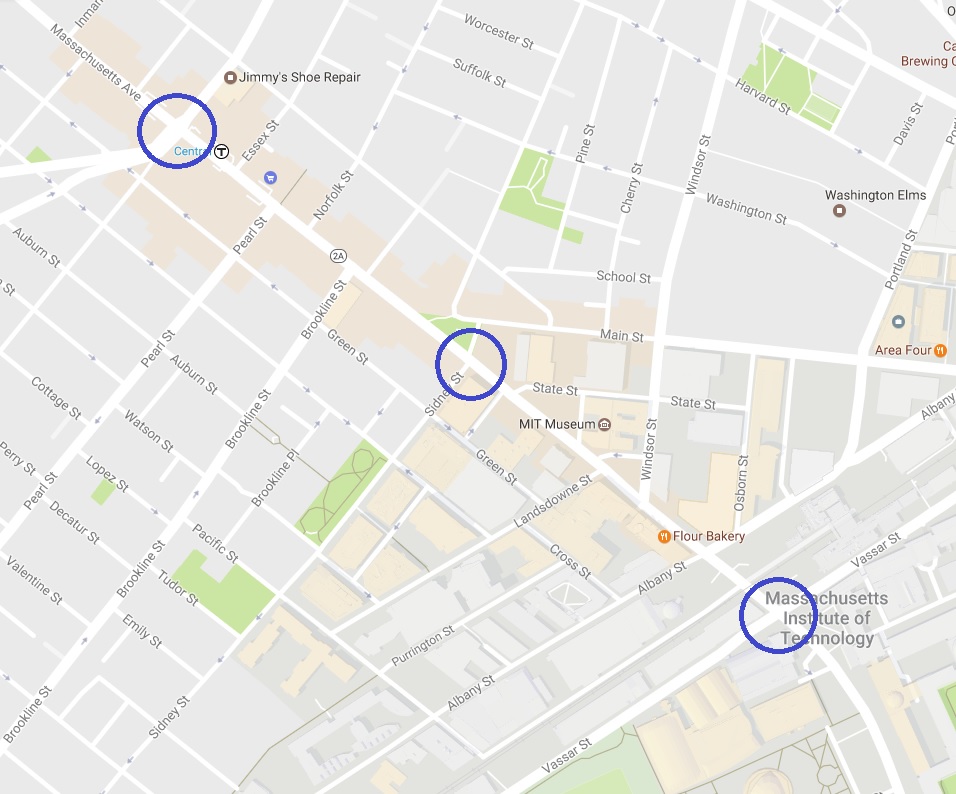Re-designing Massachusetts Avenue
Due: Class 8
Introduction
The Cambridge Director of Transportation has asked you, his trusted advisor, to help him plan his strategy with respect to current issues regarding Massachusetts Avenue between Central Square and the Harvard Bridge.
For this assignment, you will have access to the counting reports of the teams at three intersections and locations along Mass. Ave. You should walk and observe, and use the first several steps of the 19 step process as part of your background work in preparing to write the assignment. Pay explicit attention to the first step: "who are you?" and how this impacts the advice you give.
Note that each cross-section and intersection poses unique issues, but that there may be some commonality. Since the same vehicles will need to navigate the entire section, what you propose for your intersection should consider the needs of the rest of the corridor. IN addition to your general arguments, your advisee has asked you to look at a particular intersection in the corridor and make specific recommendations for design and operational changes that demonstrate your holistic approach, particularly regarding improving pedestrian safety and access to adjacent land uses, at one of the following intersections: 1) Mass. Ave. at Prospect St., 2) Mass. Ave. at Sidney St., or 3) Mass. Ave. at Vassar St.

Download a larger version of the map
Questions to Address
Your assignment is to propose solutions for a re-design of Massachusetts Avenue at one of the four locations along the corridor observed by you and your peers. In doing so, please consider the following questions and use the 19 step process to structure your memo.
- What should the key objectives be for an overall redesign of Mass. Ave. between Central Square and the Harvard Bridge?
- How is the width of the street currently allocated? How does that compare to the relative flows of users?
- What are the problems or conflicts identified by you and your peers at these locations? What is working well?
- What opportunities do you see to address these issues?
- Are there any precedents you're aware of for redesigning a street like Mass. Ave., and what can we learn from those interventions?
- What, if any, overall corridor policies or approaches do you recommend? How do they support your key objectives
- Recognizing the numbers of people moving through the corridor in different modes and at different times of day, what design interventions do you propose for your intersection? Consider how what you propose at this intersection relates to the streets radiating out one block in each direction. Note: you should use "little numbers," not precise calculations, but enough quantitative analysis to gauge the flows by mode, and consequent space needs.
- How do you propose to address the varying needs for different modes moving through the intersection at different times of day?
- How do you propose to allocate the width of the street to different users?
- With what types of interventions do you recommend (including, for example, bike lanes, separated bike lanes, bus lanes, sidewalk bumpouts, re-routing certain modes to parallel streets, etc.)?
- Do you have recommendations with respect to where left turns should be allowed/prohibited, locations of taxi stands and loading zones, and what should happen to parking?
- Do you have any recommendations with respect to how the signals should be timed, or allocated to different users?
- Feel free to use Streetmix, a hand drawing, or other software to communicate your ideas - as well as the resources listed below for ideas of interventions
- What are the likely impacts - positive and negative - of your proposed design? For what time periods and modes does it work best - and worst?
- Who are the constituencies that your design will impact, positively and negatively, and how does your design address their potential concerns?
Format: The assignment should be in the form of a memo to Joe Barr, Director of Transportation for the City of Cambridge, and can include images or diagrams if they are useful for conveying your ideas. Please maintain a limit of 6 pages, including graphics.
Discussion Teams: This is an individual assignment, and each of you will write your own memo. However, to expose you to a range of viewpoints and provide a corridor perspective, you will be grouped into teams of 3 for brainstorming and discussion. Each team will have at least one member from each intersection. We recognize that it can be challenging to coordinate schedules for meetings, but try to meet as a team at least once. We are not expecting consistency between what individuals in each team propose. Instead, the idea is just to get you thinking about the upstream and downstream consequences of what you might suggest at one point.
Street Design Resources: These are great resources for getting ideas and guidance for ways to allocate street space, the ideal widths of different elements, and some throughput numbers.
- NACTO Urban Street Design
- Boston's Complete Streets Guidelines
- Urb-I Street Design "Before-After" Photos
- ITE Traffic Calming Library
- HCM 2010: Highway Capacity Manual
- Transit Capacity and Quality of Service Manual
- Google Earth can be used for measuring curb-to-curb distances if needed
Data and Background Material
- Your classmates' counting reports
- Red Line and bus ridership for AM peak, midday, PM peak, and evening
- Auto traffic counts from the city of Cambridge
-
 Central Square Access and Circulation Study (PDF - 4.6MB)
Central Square Access and Circulation Study (PDF - 4.6MB)
